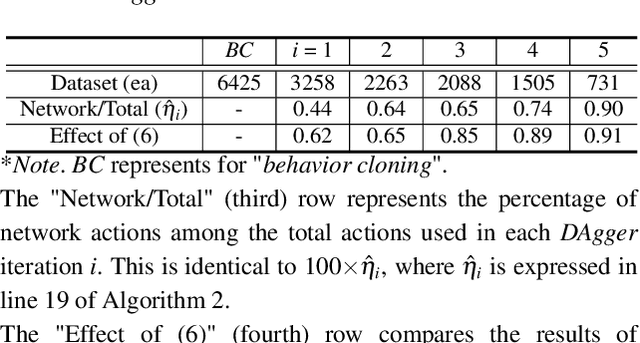Joonwoo Ahn
Vision-based Autonomous Driving for Unstructured Environments Using Imitation Learning
Feb 21, 2022



Abstract:Unstructured environments are difficult for autonomous driving. This is because various unknown obstacles are lied in drivable space without lanes, and its width and curvature change widely. In such complex environments, searching for a path in real-time is difficult. Also, inaccurate localization data reduce the path tracking accuracy, increasing the risk of collision. Instead of searching and tracking the path, an alternative approach has been proposed that reactively avoids obstacles in real-time. Some methods are available for tracking global path while avoiding obstacles using the candidate paths and the artificial potential field. However, these methods require heuristics to find specific parameters for handling various complex environments. In addition, it is difficult to track the global path accurately in practice because of inaccurate localization data. If the drivable space is not accurately recognized (i.e., noisy state), the vehicle may not smoothly drive or may collide with obstacles. In this study, a method in which the vehicle drives toward drivable space only using a vision-based occupancy grid map is proposed. The proposed method uses imitation learning, where a deep neural network is trained with expert driving data. The network can learn driving patterns suited for various complex and noisy situations because these situations are contained in the training data. Experiments with a vehicle in actual parking lots demonstrated the limitations of general model-based methods and the effectiveness of the proposed imitation learning method.
Continuous-Curvature Target Tree Algorithm for Path Planning in Complex Parking Environments
Jan 19, 2022



Abstract:Rapidly-exploring random tree (RRT) has been applied for autonomous parking due to quickly solving high-dimensional motion planning and easily reflecting constraints. However, planning time increases by the low probability of extending toward narrow parking spots without collisions. To reduce the planning time, the target tree algorithm was proposed, substituting a parking goal in RRT with a set (target tree) of backward parking paths. However, it consists of circular and straight paths, and an autonomous vehicle cannot park accurately because of curvature-discontinuity. Moreover, the planning time increases in complex environments; backward paths can be blocked by obstacles. Therefore, this paper introduces the continuous-curvature target tree algorithm for complex parking environments. First, a target tree includes clothoid paths to address such curvature-discontinuity. Second, to reduce the planning time further, a cost function is defined to construct a target tree that considers obstacles. Integrated with optimal-variant RRT and searching for the shortest path among the reached backward paths, the proposed algorithm obtains a near-optimal path as the sampling time increases. Experiment results in real environments show that the vehicle more accurately parks, and continuous-curvature paths are obtained more quickly and with higher success rates than those acquired with other sampling-based algorithms.
 Add to Chrome
Add to Chrome Add to Firefox
Add to Firefox Add to Edge
Add to Edge